Abstract
Background:
Occupational burnout, as a reaction to persistent work pressures, reduces efficiency, wastes manpower, and causes physical and psychological complications. The aim of this study was to determine the frequency and intensity of occupational burnout among pre-hospital emergency staff in Iran.
Materials and Methods:
This study was performed based on the Preferred Reporting Items for Systematic Reviews and Meta-Analyses (PRISMA) guidelines. Data resources included Scientific Information Database (SID), Magiran, Islamic World Science Citation Center (ISC), Irandoc, PubMed, Scopus, Web of Science, and Google Scholar.
Results:
Initially, 178 articles were extracted, and then 13 articles were finally analyzed. Overall,2034 pre-hospital emergency personnel were examined. Mean of occupational burnout in term of frequency, respectively for emotional exhaustion (16.78, 95% CI = 8.89-24.67, I2 = 62.30%, p = 0.004), depersonalization (11.57, 95% CI = 6.97-16.18, I2 = 68.50%, p = 0.001) and the lack of personal accomplishment (16.11, 95% CI = 8.60 -23.62, I2 = 74.70%, p = 0 <001) were determined. Also, in term of intensity, respectively for emotional exhaustion (17.90, 95% CI = 8.24-27.57, I2 = 64.80, p = 0.004), depersonalization (11.20, 95% CI = 6.80-16.22, I2 = 49.60%, p = 0.044) and the lack of personal accomplishment (23.45, 95% CI = 13.41 -33.49, I2 = 84.80%, p = 0 <001) were determined.
Conclusions:
According to findings, depersonalization and lack of personal accomplishment had moderate and high-level, respectively. Therefore, it is necessary health policymakers pay special attention to identifying and resolving the causes of occupational burnout in this population.
Keywords: Burnout, emergency medical services, emergency medical technicians, Professional
Introduction
Occupational burnout is a reaction to persistent work or organizational pressures and has three dimensions: emotional exhaustion, depersonalization, and the lack of personal accomplishment. Today, the frequency of occupational burnout has increasingly surged. The burnout has contributed to high rates of divorce, job losses, and physical and mental illnesses, as well as decreased workforce and flawed economy and production.[1,2,3,4] Occupational burnout for health care providers is an important issue because they experience physical and psychological stress.[5]
Emergency Medical Technicians (EMTs) work in stressful environments (e.g., scene of an accident). In their missions, these individuals may encounter with people with psychological disorders, or drugs or alcohol abusers who usually show violent and aggressive behaviors; therefore, the technicians should cautiously approach them to avoid being attacked by these people.[6,7,8] The results of studies have shown that the prevalence of occupational burnout among physicians, nurses, and EMTs was 70%, 50%, and 35%, respectively. Occupational burnout in EMTs, physicians, and health care providers may result in adversely affect patient care, job dissatisfaction, and increased errors respectively. Also, burnout may be associated with adverse health consequences such as insomnia, depression, and hypertension.[9,10] The study of Khatiban et al, showed that Iranian EMTs have a high level of emotional exhaustion and depersonalization.[11]
The late diagnosis of burnout and delayed interventional and preventive measures can compromise personnel's work quality and efficiency and reduce their physical and mental health, which can ultimately impose extra costs of absenteeism, relocation, and loss of productivity on health care organizations.[12,13,14,15] Occupational burnout has been affected by job stress. Therefore, measures such as occupational support of employees and their participation in decision making can reduce stress and consequently occupational burnout. On the contrary, resilience plays an important role in preventing occupational burnout. In addition, the health care quality of services increases with reducing job stress..[16,17]
Due to the occupational conditions and stress of pre-hospital emergency personnel, it is of great importance to identify the frequency and risk of occupational burnout in Emergency Medical Services (EMS) personnel who are first responders present at patients' sides and have vital roles in saving human beings' lives. Therefore, determining the rate of occupational burnout in pre-hospital emergency personnel can provide important information for policymakers. The present study was conducted to determine the frequency and intensity of occupational burnout among pre-hospital emergency personnel in Iran.
Materials and Methods
This study is a systematic review and meta-analyses. The Preferred Reporting Items for Systematic Reviews and Meta-Analyses (PRISMA) guidelines were used to conduct the study.[18] Selection and qualification of studies and data extraction were independently performed by two researchers (AS and MG). In case of disagreements, a third researcher was included to reach a decision (KJ). To find related studies, Scientific Information Database (SID), Islamic World Science Citation Center (ISC), Magiran, Scopus, PubMed, Irandoc, Web of Science, and Google Scholar data resources were searched using valid English keywords and their Persian equivalents. These included “burnout”, “professional”, “occupational”, “career”, “job”, “Emergency Medical Services Personnel”, “Emergency Medical Services Staff”, “Prehospital Emergency Personnel”, “Emergency Medical Technician”, “Emergency Medicine Technician”, “Emergency Paramedic”, “paramedic”, “Iran”. The searches were conducted to the end of 2019. The types of search strategies are listed in Table 1.
Table 1.
The types of search strategy
| Databases | Search Strategy |
|---|---|
| PubMed | ((“Professional Burnout” OR “Occupational Burnout” OR “Career Burnout” OR “Job Burnout” OR Burnout) AND (“Emergency Medical Services personnel” OR “Emergency Medical Services Staff” OR “Prehospital Emergency personnel” OR “Prehospital Emergency Staff” OR “Emergency Medicine Technician*” OR “Emergency Paramedic*” OR “Emergency Medical Technician*” OR Paramedic*) AND Iran) |
| Scopus | (ALL(“Professional Burnout”) OR ALL(“Occupational Burnout”) OR ALL (“Career Burnout”) OR ALL (“Job Burnout”) OR ALL (Burnout)) AND (ALL (“Emergency Medical Services personnel”) OR ALL(“Emergency Medical Services Staff”) OR ALL (“Prehospital Emergency personnel”) OR ALL(“Prehospital Emergency Staff”) OR ALL (“Emergency Medicine Technician*”) OR ALL (“Emergency Paramedic*”) OR ALL (“Emergency Medical Technician*”) OR ALL (Paramedic*)) AND ALL (Iran) |
| WOS* | (TS=(“Professional Burnout”) OR TS= (“Occupational Burnout”) OR TS= (“Career Burnout”) OR TS= (“Job Burnout”) OR TS= (Burnout)) AND (TS= (“Emergency Medical Services personnel”) OR TS=( “Emergency Medical Services Staff”) OR TS= (“Prehospital Emergency personnel”) OR TS=(“Prehospital Emergency Staff”) OR TS= (“Emergency Medicine Technician*”) OR TS= (“Emergency Paramedic*”) OR TS= (“Emergency Medical Technician*”) OR TS= (Paramedic*)) AND TS= (Iran)) |
*WOS: Web of Science
In this study, inclusion criteria were included all articles (both Persian and English) reporting the mean and standard deviation frequency and intensity of occupational burnout in pre-hospital emergency personnel in Iran to the end of 2019. Only studies using the Maslach Burnout Inventory (MBI) instrument were included. Exclusion criteria were considered as using instruments other than the above-mentioned, full-text unavailability, and an interventional design. Also, brief reports and systematic reviews were excluded. After searching the mentioned data resources, 178 original articles entered into the EndNote X7 software. After deleting duplicates, the titles and abstracts of 156 articles were reviewed. Among these, 23 potentially related studies were identified. In the next step, two researchers independently and carefully read the full texts of these studies in detail. Finally, 13 eligible studies were selected. To check the quality of the studies, a Strengthening the Reporting of Observational Studies in Epidemiology (STROBE) checklist was used.[19] The minimum and maximum scores obtained in this checklist were 0 and 44, respectively. Those studies that obtained a minimum score of 16 were selected for the meta-analysis.[20] The required data from the final studies were extracted using a pre-prepared checklist to record first authors' names, study place, sample size, year of publication, and the frequency and intensity of occupational burnout in each of emotional exhaustion, depersonalization, and the lack of personal accomplishment dimensions. In each study, the means and standard deviations of occupational burnout were extracted for individual dimensions. The I2 test was used to investigate the heterogeneity among the studies. Generally, I2 values of <25, 25 to 75, and >75 indicate low, moderate, and high heterogeneity, respectively.[21] Based on the obtained I2 index, the random effects model was used for meta-analysis. Meta-regression was used to investigate the relationship between occupational burnout dimensions and the year of study. Also in this study, the Begg test was used to evaluate the publication of bias. The data were analyzed using STATA software (version 14).
Ethical considerations
This study was approved by the ethics committee of Shahid Beheshti University of Medical Sciences, Tehran, Iran (IR.SBMU.PHNS.REC.1399.011). In this systematic review and meta-analysis, the collected data were only used for scientific purposes, and intellectual property was respected in the reporting and publication of the results.
Results
Following the initial search, 178 studies were identified from which the titles and abstracts of 156 studies were further reviewed after removing duplicates. Finally, 13 eligible studies were qualified and then entered the meta-analysis phase. Figure 1 shows the steps of the study selection process. In the present study,2034 pre-hospital emergency personnel were studied. All the studies had a cross-sectional design. Table 2 shows the characteristics and the data extracted from the studies. All the included studies were used the MBI. This instrument has 22 items measuring the frequency and intensity of occupational burnout in three dimensions of emotional exhaustion, depersonalization, and the lack of personal accomplishment. For the frequency of emotional exhaustion, the scores of =17, 18-29, and =30 were considered as low, moderate, and high emotional exhaustion, respectively. In terms of the intensity of emotional exhaustion, the scores of =25, 26-39, and =40 were designated as low, moderate, and high emotional exhaustion, respectively. Considering the frequency of depersonalization, the scores of =5, 6-11, and =12 were designated as low, moderate, and high prevalence, respectively. In terms of depersonalization intensity, low, moderate, and high categories were assigned with the score of =6, 7-14, and =15, respectively. Finally, regarding the frequency of the lack of personal accomplishment, the scores of =40, 34-39, and =33 corresponded to low, moderate, and high frequencies, respectively. The low, moderate, and high lack of accomplishment were characterized by the scores of =44, 43-37, and =36, respectively.[22]
Figure 1.
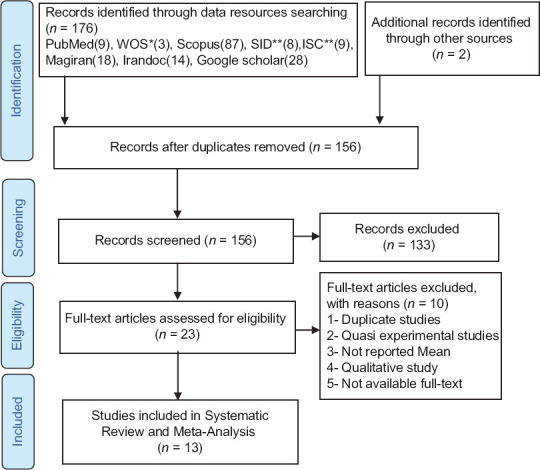
Flowchart of the Selection of Studies Based on Preferred Reporting Items for Systematic Reviews and Meta-Analyses (PRISMA). *WOS: Web of Science. **SID: Scientific Information Database. ***ISC: Islamic World Science Citation Center
Table 2.
The characteristics of the selected studies in meta-analysis
| First author | Place | Year of publication | Sample size | Mean (SD) Frequency | Mean (SD) intensity | ||||
|---|---|---|---|---|---|---|---|---|---|
| EE* | DP** | LPA*** | EE* | DP** | LPA*** | ||||
| Moradi[22] | Isfahan | 2015 | 68 | 21.21 (11.95) | 8.94 (5.43) | 26.82 (5.72) | 25.59 (20.39) | 10.57 (7.83) | 34.60 (8.46) |
| Eslami AA[23] | South Khorasan | 2017 | 89 | - | - | - | 20.25 (7.91) | 10.97 (5.41) | 32.08 (8.67) |
| Ghaniyoun[24] | Tehran | 2017 | 285 | 20.76 (10.90) | 20.29 (7.19) | 22.44 (5.35) | 21.65 (7.36) | 20.48 (7.36) | 22.92 (5.42) |
| Moradchelle[25] | Shahroud | 2019 | 100 | 8.40 (7.84) | 37.60 (7.67) | 8.90 (4.23) | 9.65 (8.48) | 40.55 (12.90) | 11.80 (5.01) |
| Ebrahimi[26] | Shahroud | 2014 | 114 | 28.12 (15.36) | 8.46 (6.25) | 36.18 (14.76) | 41.35 (16.43) | 11.32 (5.54) | 38.32 (14.16) |
| Moshtagh Eshgh[16] | Golestan | 2015 | 206 | 20.71 (7.66) | 10.67 (3.61) | 13.95 (10.56) | - | - | - |
| Haji Mohammad H[27] | Qom | 2017 | 150 | - | - | - | 23.10 (14.41) | 11.07 (5.41) | 38 (9.20) |
| Shahsavani[28] | Golestan | 2019 | 206 | 20.71 (7.66) | 10.67 (3.61) | 13.95 (10.56) | - | - | - |
| Shareinia[29] | Gonabad | 2017 | 100 | - | - | - | 24.53 (11.22) | 10.60 (4.94) | 19.29 (6.48) |
| Khatiban[30] | Hamedan | 2012 | 110 | 20.85 (15) | 7.87 (5.97) | 22.73 (7.95) | 24.96 (17.10) | 11.85 (9.48) | 28.34 (16.10) |
| Rezaei Ronaghi[31] | Kashan | 2017 | 92 | 27.04 (12.90) | 14.28 (9.38) | 14.80 (9.09) | - | - | - |
| Bahadori[32] | Tehran | 2019 | 308 | 4.28 (0.77) | 5.03 (0.79) | 4.17 (1.20) | 3.68 (0.99) | 4.50 (1.43) | 5.01 (1.14) |
| Akbar Aghaeinejad[33] | Golestan | 2014 | 206 | 20.71 (7.66) | 10.67 (3.61) | 10.56 (13.96) | - | - | - |
*EE: Emotional Exhaustion, **DP: Depersonalization, ***LPA: Lack of Personal Accomplishment
The results of meta-analysis showed that the means of the frequency of occupational burnout in terms of emotional exhaustion, depersonalization, and the lack of personal accomplishment were 16.78 (95% CI = 8.89-24.67, I2 = 62.30%, p = 0.004), 11.57 (95% CI = 6.97-16.18, I2 = 68.50%, p = 0.001) and 16.11 (95% CI = 8.60 -23.62, I2 = 74.70%, p = 0 <001), respectively [Figures 2–4]. Our results showed that the mean frequency of occupational burnout in terms of emotional exhaustion, depersonalization, and the lack of personal accomplishment were low, moderate, and high, respectively. The results of the Begg test showed that publication bias for occupational burnout frequency was not considerable (emotional exhaustion (p = 0.721), depersonalization (p = 0. 371), lack of personal accomplishment (p = 0.858)).
Figure 2.
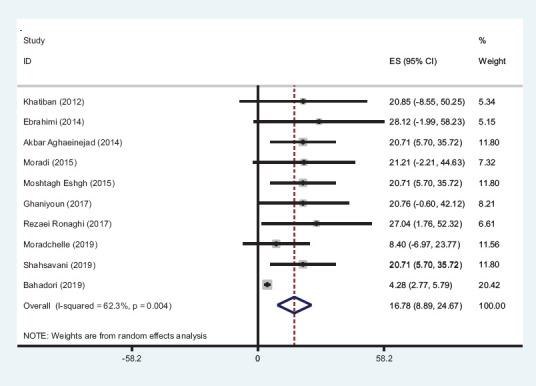
Forest plot for the average frequency of emotional exhaustion in general and in individual studies with 95% confidence intervals
Figure 4.
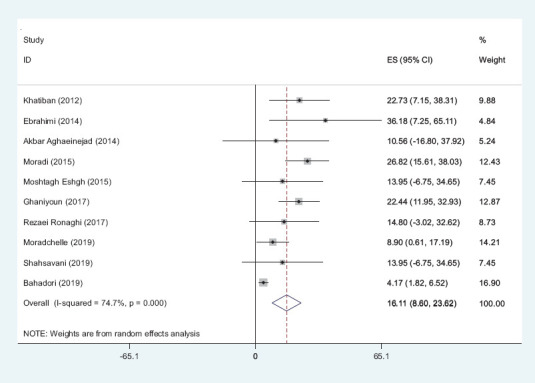
Forest plot for the average frequency of the lack of personal accomplishment in general and in individual studies with 95% confidence intervals
Furthermore, the means of the intensity of occupational burnout regarding emotional exhaustion, depersonalization, and the lack of personal accomplishment were 17.90 (95% CI = 8.24-27.57, I2 = 64.80, p = 0.004), 11.20 (95% CI = 6.80-16.22, I2 = 49.60%, p = 0.044) and 23.45 (95% CI = 13.41 -33.49, I2 = 84.80%, p = 0 <001), respectively [Figures 5–7]. Results showed that the mean intensity of occupational burnout in terms of emotional exhaustion, depersonalization, and the lack of personal accomplishment were also obtained as low, moderate, and high, respectively. Also, the Begg test showed that publication bias for occupational burnout intensity was not considerable (emotional exhaustion (p = 0. 677), depersonalization (p = 0.173), and lack of personal accomplishment (p= 0.297)). The results of meta-regression showed that the depersonalization frequency trend was increasing, but other dimensions of occupational burnout were decreasing.
Figure 5.
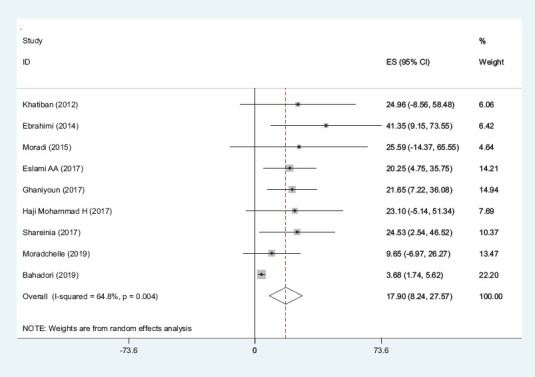
Forest plot for the mean intensity of emotional exhaustion in general and in individual studies with 95% confidence intervals
Figure 7.
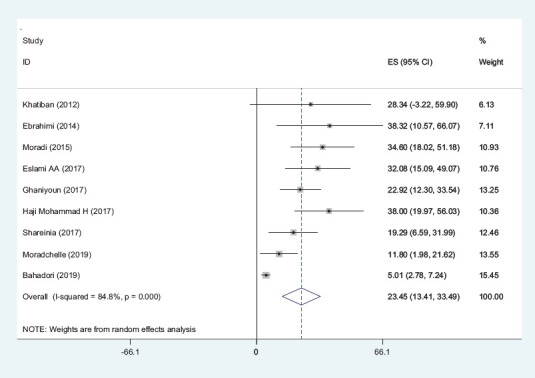
Forest plot for the mean intensity of the lack of personal accomplishment in general and in individual studies with 95% confidence intervals
Discussion
The present study was conducted to determine the frequency and intensity of occupational burnout among pre-hospital emergency personnel in Iran. According to our findings, the lowest and highest frequency and intensity of occupational burnout in pre-hospital emergency personnel in Iran were related to emotional exhaustion and the lack of personal accomplishment dimensions, respectively. The results of a meta-analysis study showed that the prevalence of occupational burnout in emergency department nurses was emotional exhaustion (31%), depersonalization (36%), and the lack of personal accomplishment (29%) respectively. Nurses who are working in the emergency department experience anxiety, high workload, and types of workplace violence.[34] Therefore, these factors can increase occupational burnout. In the present study, the means of frequency and intensity of occupational burnout in terms of emotional exhaustion were obtained as 16.78 [Figure 2] and 17.90 [Figure 4], respectively. In other studies, the frequencies of emotional exhaustion among pre-hospital emergency personnel were reported as 20% by Juliá-Sanchis et al.[3] in Spain, 44% by Kalemoglu et al.[35] in Turkey, 13% by Boland et al.[36] in the US state of Minnesota, and 20-40% in the study of Baier et al.[1] Studies on nurses and physicians have also reported the frequencies of 27%[37] and 41%[38] for emotional exhaustion, respectively. Emotional exhaustion, which plays a decisive role in job satisfaction, can be resulted from conflicts and ambiguities in roles, functional overload, intra- and inter-individual conflicts, as well as the lack of authority and rewards.[35,36,37,38,39] In addition, constant exposition of health care providers to emotional distresses due to the nature of their careers can contribute to occupational burnout.[1] In the present study, the means of frequency and intensity of occupational burnout regarding the depersonalization dimension were 11.57 and 11.20 Figure 3 and Figure 6, respectively. In the study of Moukarzel et al.,[40] the frequency of depersonalization in emergency personnel was reported as 29.6%. In studies conducted in Turkey,[34] Spain[3] and the United States,[35] the frequencies of depersonalization among pre-hospital emergency personnel were reported 32.2%, 10.10%, and 6.9%, respectively. Persistent emotional exhaustion reduces individuals' mental capability which can lead to extreme indifference toward the job and even clients. Therefore, depersonalization can be considered as a concept closely related and compatible with emotional exhaustion. Nevertheless, hereditary, social, and familial factors can also contribute to depersonalization.[35,36,37,38,39,40]
Figure 3.
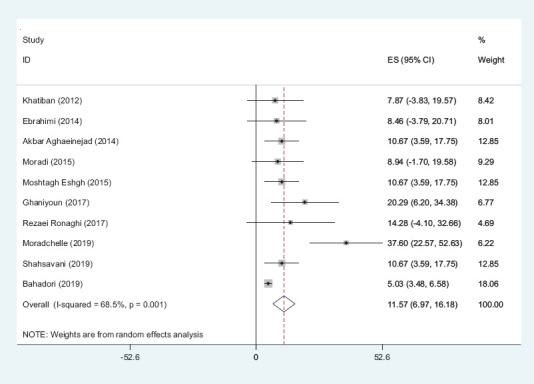
Forest plot for the average frequency of depersonalization in general and in individual studies with 95% confidence intervals
Figure 6.
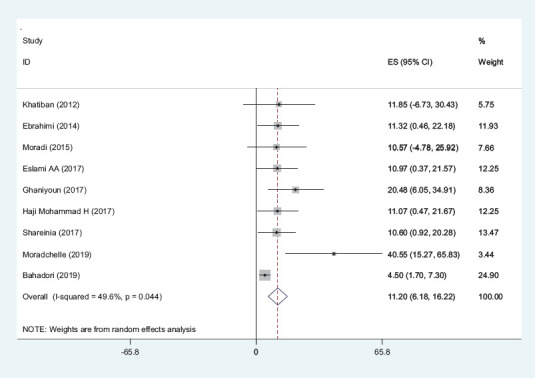
Forest plot for the mean intensity of depersonalization in general and in individual studies with 95% confidence intervals
The lack of personal accomplishment reduces the competency in performing one's duties and promotes a negative self-assessment toward performing tasks.[39,40] In the present study, the average frequency and intensity of occupational burnout in terms of the lack of personal accomplishment were obtained as 16.11 [Figure 4] and 23.45 [Figure 7], respectively. The respective frequencies were reported as 37% by Juliá-Sanchis et al.[3] in Spain, 28% by Kalemoglu et al.[35] in Turkey, and 39.10% by Boland et al.[36] in the US state of Minnesota. Engaging personnel in organizational decisions, appreciating their efforts, and boosting their motivations can increase employees' self-esteem at workplace and thus mitigate their lack of personal accomplishments.[31]
Different rates of occupational burnout may root in cultural determinants in various communities, individual characteristics, and variable interpretations and self-assessments regarding the definition of burnout concept in different societies.[41] In a study in Colombia,[42] the frequency of occupational burnout among nurses was reported as 1.90%. In the recent study, relatively high ratios of nurses presented severe emotional exhaustion (15.50%), depersonalization (16.50%), and the lack of personal accomplishment (9.70%). Another study showed that empathy among nurses reduced occupational burnout and increased job satisfaction.[43] Overall, educating health care providers about how to adapt to their professions can strengthen their ability to cope with high workloads[3] and therefore reduce occupational burnout. As a result, prehospital emergency personnel are exposed to occupational burnout like the other health care providers. Hence, by conducting this comprehensive study and achieving the rate of occupational burnout in pre-hospital emergency personnel can be a turning point in addressing this important issue in this population. One of the limitations of this study was high heterogeneity among the included studies. In addition, the studies reported the mean of occupational burnout in individual dimensions instead of reporting an overall mean. So, it was not possible to report the overall mean of occupational burnout. Finally, most of the studies did not report the means of their participants' age and working experience.
Conclusion
The findings of this study showed moderate frequency and intensity of occupational burnout in terms of depersonalization while high levels in terms of the lack of personal accomplishment among pre-hospital emergency personnel in Iran. Therefore, it is necessary health policymakers pay special attention to identifying and resolving the causes of occupational burnout in this population and carry planning and measures appropriate. This can prevent absenteeism, job dissatisfaction, and adverse effects on health care systems and improve the quantity and quality of pre-hospital emergency services. It is suggested to examine barriers and facilitators of occupational burnout in pre-hospital emergency staff in future studies.
Financial support and sponsorship
Shahid Beheshti University of Medical Sciences, Tehran, Iran
Conflicts of interest
Nothing to declare.
Acknowledgments
The authors thank Shahid Beheshti University of Medical Sciences, Tehran, Iran for the financial support of this research.
References
- 1.Baier N, Roth K, Felgner S, Henschke C. Burnout and safety outcomes-a cross-sectional nationwide survey of EMS-workers in Germany. BMC Emerg Med. 2018;18:24. doi: 10.1186/s12873-018-0177-2. [DOI] [PMC free article] [PubMed] [Google Scholar]
- 2.Sheikhkanlooye Milan J, Fadaei Yushanloie KH, Hoseinzadeh F, Mohammadpour Y, Bahrami B, Farshbaf Mani Sefat F. Predicting job burnout according to organizational climate and work ethics with the mediation of job motivation in Urmia emergency medical staff in 2017. J Adv Pharm Edu Res. 2020;10:43–7. [Google Scholar]
- 3.Juliá-Sanchis R, Richart-Martínez M, García-Aracil N, José-Alcaide L, Piquer-Donat T, Castejón-de-la-Encina ME. Measuring the levels of burnout syndrome and empathy of Spanish emergency medical service professionals. Australas Emerg Care. 2019;22:193–9. doi: 10.1016/j.auec.2019.04.003. [DOI] [PubMed] [Google Scholar]
- 4.Leszczynski P, Panczyk M, Podgórski M, Owczarek K, Galazkowski R, Mikos M, et al. Determinants of occupational burnout among employees of the emergency medical services in Poland. Ann Agric Environ Med. 2019;26:114–9. doi: 10.26444/aaem/94294. [DOI] [PubMed] [Google Scholar]
- 5.ALmutairi MN, Mahalli AA. Burnout and coping methods among emergency medical services professionals. J Multidiscip Healthcare. 2020;13:271–9. doi: 10.2147/JMDH.S244303. [DOI] [PMC free article] [PubMed] [Google Scholar]
- 6.Durand AC, Bompard C, Sportiello J, Michelet P, Gentile S. Stress and burnout among professionals working in the emergency department in a French university hospital: Prevalence and associated factors. Work. 2019;63:57–67. doi: 10.3233/WOR-192908. [DOI] [PubMed] [Google Scholar]
- 7.Motie MR, Kalani MR, Samadi A, Eshaghi H, Ghobadi P. Prevalence of job stressors in male pre-hospital emergency technicians. J Fundam Mental Health. 2010;12:420–429. [Persian] [Google Scholar]
- 8.Asghari E, Khaleghdoust T, Asgari F, Kazemnejad E. Effective factors on nurses' job satisfaction. J Holist Nurs Midwifery. 2010;20:1–7. [Google Scholar]
- 9.Crowe RP, Fernandez AR, Pepe PE, Cash RE, Rivard MK, Wronski R, et al. The association of job demands and resources with burnout among emergency medical services professionals. J Am College Emerg Physicians Open. 2020;1:6–16. doi: 10.1002/emp2.12014. [DOI] [PMC free article] [PubMed] [Google Scholar]
- 10.Dubale BW, Friedman LE, Chemali Z, Denninger JW, Mehta DH, Alem A, et al. Systematic review of burnout among healthcare providers in sub-Saharan Africa. BMC Public Health. 2019;19:1247. doi: 10.1186/s12889-019-7566-7. [DOI] [PMC free article] [PubMed] [Google Scholar]
- 11.Khatiban M, Hosseini S, Bikmoradi A, Roshanaei G, Karampourian A. Occupational burnout and its determinants among personnel of emergency medical services in Iran. Acta Medica Iranica. 2015;29:711–6. [PubMed] [Google Scholar]
- 12.Cicchitti C, Cannizzaro G, Rosi F, Maccaroni R, Menditto VG. Burnout syndrome in pre-hospital and hospital emergency. Cognitive study in two cohorts of nurses. Recenti Prog Med. 2014;105:275–80. doi: 10.1701/1574.17110. [DOI] [PubMed] [Google Scholar]
- 13.Wu S, Zhu W, Wang Z, Wang M, LAN Y. Relationship between burnout and occupational stress among nurses in china. J Adv Nurse. 2007;59:233–9. doi: 10.1111/j.1365-2648.2007.04301.x. [DOI] [PubMed] [Google Scholar]
- 14.Ferraro L, La Cascia C, De Santis A, Sideli L, Maniaci G, Orlando IM, et al. A cross-sectional survey on burnout prevalence and profile in the Sicilian population of ambulance driver-rescuers. Prehosp Disaster Med. 2020;35:133–40. doi: 10.1017/S1049023X20000059. [DOI] [PubMed] [Google Scholar]
- 15.De Stefano C, Philippon AL, Krastinova E, Hausfater P, Riou B, Adnet F, et al. Effect of emergency physician burnout on patient waiting times. Intern Emerg Med. 2018;13:421–8. doi: 10.1007/s11739-017-1706-9. [DOI] [PubMed] [Google Scholar]
- 16.Moshtagh Eshgh Z, Aghaeinejad AA, Peyman A, Amirkhani A, Taghinezhad F, Sheikhi AA. The relationship between occupational stresses with job burnout in pre-hospital emergency staff. Hakim Jorjani J. 2015;2:33–41. [Persian] [Google Scholar]
- 17.Ebadi A, Froutan R, Malekzadeh J. The design and psychometric evaluation of the emergency medical services resilience scale (EMSRS) Int Emerg Nurs. 2019;42:12–8. doi: 10.1016/j.ienj.2018.09.002. [DOI] [PubMed] [Google Scholar]
- 18.The PRISMA Group. Moher D, Liberati A, Tetzlaff J, Altman DG. Preferred reporting items for systematic reviews and meta-analyses: The PRISMA statement. PLoS Med. 2009;6:e1000097. doi: 10.1371/journal.pmed.1000097. [DOI] [PMC free article] [PubMed] [Google Scholar]
- 19.Vandenbroucke JP, von Elm E, Altman DG, Gøtzsche PC, Mulrow CD, Pocock SJ, et al. Strengthening the reporting of observational studies in epidemiology (STROBE): Explanation and elaboration. Int J Surg. 2014;12:1500–24. doi: 10.1016/j.ijsu.2014.07.014. [DOI] [PubMed] [Google Scholar]
- 20.Yousefi K, Larijani HA, Golitaleb M, Sahebi A. Knowledge, attitude and performance associated with disaster preparedness in Iranian nurses: A systematic review and meta-analysis. Adv J Emerg Med. 2019;3:e42. doi: 10.22114/ajem.v0i0.204. [DOI] [PMC free article] [PubMed] [Google Scholar]
- 21.Sahebi A, Jahangiri K, Sohrabizadeh S, Golitaleb M. Prevalence of workplace violence types against personnel of emergency medical services in Iran: A systematic review and meta-analysis. Iran J Psychiatry. 2019;14:325–34. [PMC free article] [PubMed] [Google Scholar]
- 22.Moradi Z, Eslami AA, Hasanzadeh A. Job burnout status among pre-hospital emergency technicians. Iran J Emerg Med. 2015;2:28–32. [Persian] [Google Scholar]
- 23.Eslami AliAbadi H, Asadi F. Burnout among emergency medical services (EMS) staff. Q J Nurs Manag. 2017;5:62–70. [Persian] [Google Scholar]
- 24.Ghaniyoun A, Shakeri K, Heidari M. The association of psychological empowerment and job burnout in operational staff of Tehran emergency center. Indian J Crit Care Med. 2017;21:563–7. doi: 10.4103/ijccm.IJCCM_56_17. [DOI] [PMC free article] [PubMed] [Google Scholar]
- 25.Moradchelle A, Noyani A, Yekesadat M, Seidabadi A, Azizeddin S, Largani HA, et al. A survey on the status of job burnout among pre-hospital emergency personnel in Shahroud. Iran J Emerg Med. 2019;6:11. [Persian] [Google Scholar]
- 26.Ebrahimi H, Navidian A, Ameri M, Sadeghi M. Burnout, dimensions and its related factors in the operational staff of medicine emergency. J Health Promot Manag. 2014;3:16–26. [Persian] [Google Scholar]
- 27.Haji Mohammad Hoseini M, Ghanbari Afra L, Aliakbarzade Arani Z, Abdi M. Mental health and job burnout among pre-hospital emergency care personnel. Health Emerg Disasters. 2017;2:89–94. [Google Scholar]
- 28.Shahsavani A, Aghaeinezhad AA, Royani Z. Investigation of job burnout and its related factors in pre-hospital emergency medical staff. Navid No. 2019;21:29–39. [Persian] [Google Scholar]
- 29.Shareinia H, Khalilian R, Bloochi Beydokhti T, Javadi H. Relationship between job satisfaction and burnout among prehospital emergency staff. Q J Nurs Manag. 2017;6:9–19. [Persian] [Google Scholar]
- 30.Khatiban M, Hosseini S, Beikmoradi A. Burnout in the personnel of the emergency medical services in Hamadan province. Scientific J Hamadan Nurs Midwifery Faculty. 2012;20:5–15. [Persian] [Google Scholar]
- 31.Rezaei Ronaghi J, Paravar M, Rezaei M, Ebrahimi H. Relationship between burnout and social support in emergency medical personnel in Kashan city. J Knowledge Health. 2017;11:63–72. [Persian] [Google Scholar]
- 32.Bahadori M, Ravangard R, Raadabadi M, Hosseini-Shokouh SM, Behzadnia MJ. Job stress and job burnout based on personality traits among emergency medical technicians. Trauma Mon. 2019;24:24–31. [Google Scholar]
- 33.Akbar Aghaeinejad A, Eshgh ZM, Peyman A, Sabzi Z. The relationship between occupational burnout to mental health in pre-hospital emergency personnel. Adv Environ Biol. 2014;20:754–61. [Google Scholar]
- 34.Gómez-Urquiza JL, La Fuente-Solana D, Emilia I, Albendín-García L, Vargas-Pecino C, Ortega-Campos EM. Prevalence of burnout syndrome in emergency nurses: A meta-analysis. Crit Care Nurse. 2017;37:e1–9. doi: 10.4037/ccn2017508. [DOI] [PubMed] [Google Scholar]
- 35.Kalemoglu M, Keskin O. Burnout syndrome at the emergency service. Scand J Trauma Resusc Emerg Med. 2006;14:37–40. [Google Scholar]
- 36.Boland LL, Kinzy TG, Myers RN, Fernstrom KM, Kamrud JW, Mink PJ, et al. Burnout and exposure to critical incidents in a cohort of emergency medical services workers from Minnesota. West J Emerg Med. 2018;19:987–95. doi: 10.5811/westjem.8.39034. [DOI] [PMC free article] [PubMed] [Google Scholar]
- 37.Dall'Ora C, Griffiths P, Ball J, Simon M, Aiken LH. Association of 12 h shifts and nurses' job satisfaction, burnout and intention to leave: Findings from a cross-sectional study of 12 European countries. BMJ Open. 2015;5:e008331. doi: 10.1136/bmjopen-2015-008331. [DOI] [PMC free article] [PubMed] [Google Scholar]
- 38.Shanafelt TD, Hasan O, Dyrbye LN, Sinsky C, Satele D, Sloan J, et al. Changes in burnout and satisfaction with work-life balance in physicians and the general US working population between 2011 and 2014. Mayo Clin Proc. 2015;90:1600–13. doi: 10.1016/j.mayocp.2015.08.023. [DOI] [PubMed] [Google Scholar]
- 39.Tarcan GY, Tarcan M, Top M. An analysis of relationship between burnout and job satisfaction among emergency health professionals. Total Qual Manag Bus. 2017;28:1339–56. doi: 10.1016/j.apnr.2017.02.011. [DOI] [PubMed] [Google Scholar]
- 40.Moukarzel A, Michelet P, Durand AC, Sebbane M, Bourgeois S, Markarian T, Bompard C, Gentile S. Burnout syndrome among emergency department staff: Prevalence and associated factors. Biomed Res Int. 2019;2019 doi: 10.1155/2019/6462472. doi: 10.1155/2019/6462472. [DOI] [PMC free article] [PubMed] [Google Scholar]
- 41.Maslach C, Schaufeli WB, Leiter MP. Job burnout. Ann Rev Psychol. 2001;52:397–422. doi: 10.1146/annurev.psych.52.1.397. [DOI] [PubMed] [Google Scholar]
- 42.Tuesca-Molina R, Urdaneta M, Lafaurie M, Torres G, Serpa D. Burnout syndrome in nurses of the metropolitan area of Barranquilla. Salud Uninorte. 2006;22:84–91. [Google Scholar]
- 43.Taleghani F, Ashouri E, Saburi M. Empathy, burnout, demographic variables and their relationships in oncology nurses. Iran J Nurs Midwifery Res. 2017;22:41. doi: 10.4103/ijnmr.IJNMR_66_16. [DOI] [PMC free article] [PubMed] [Google Scholar]


